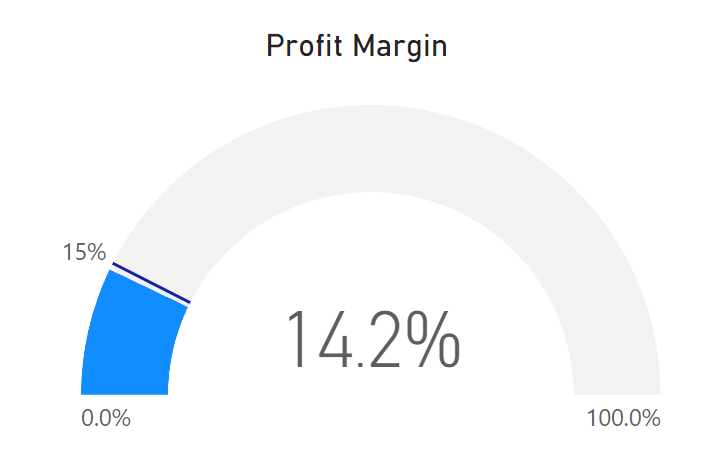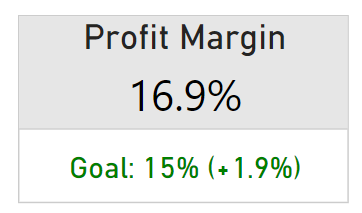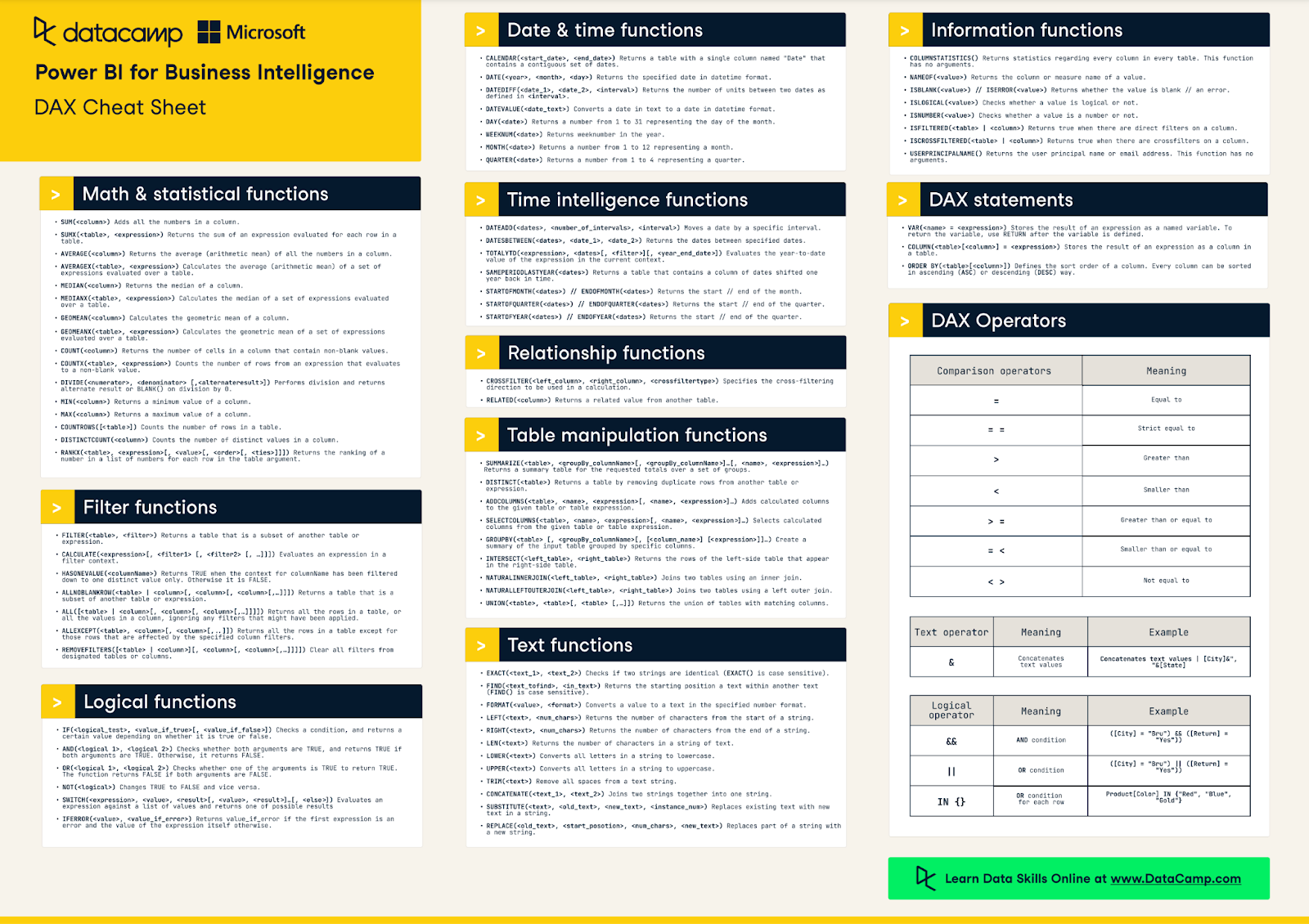Track
This tutorial will demonstrate how to effectively visualize key business objectives and metrics (i.e., KPIs) in Power BI.
We'll use a sample dataset you can access from within Power BI. This sample dataset contains financial data showing sales per product per month. If you’re unfamiliar with analyzing financial data, check out our skill track on Financial Reporting in Power BI.
To get started with Power BI, check out our Power BI Fundamentals skill track and keep our Power BI cheat sheet on hand for quick reference.
The DataCamp Power BI Cheat Sheet
What are Power BI KPIs?
Before we begin, let's define what KPIs are and how we can visualize them in Power BI.
KPIs (Key Performance Indicator) help you measure how effectively your company achieves key business objectives.
In Power BI, you can visualize KPIs using a specific KPI visual, which shows the KPI, the target, and its trend over time.
Alternatively, you can present your KPIs using the card or gauge visuals. You can also get creative with measures and formatting to incorporate KPIs into your Power BI reports. Here, we'll review both the traditional KPI visual and some alternative methods.
You can learn more about customizing and optimizing your KPIs with our webinar on calculating KPIs with DAX.
KPIs in Power BI are not just about visual appeal. They enable businesses to:
- Monitor their most important metrics at a glance.
- Track these business metrics against a pre-defined target.
- Identify trends and patterns that could indicate business opportunities or risks.
If you are a beginner in learning Power BI and want to pick up the basics quickly, then our Power BI for Beginners tutorial is an ideal choice for you.
However, if you are ready to take on some in-depth Power BI courses, our Introduction to Power BI course is the best place to begin.
Master Power BI From Scratch
Choosing Your KPIs
Always ensure you have clear, measurable goals before you add KPI visuals to your dashboards. Your KPIs should closely align with the company's business objectives.
Less is more when it comes to KPIs. Avoid adding too many KPI visuals to your dashboards.
We'll consider a common KPI for many businesses: profit margin. We also set an arbitrary target of 15% for our profit margin.
Step-by-Step Guide to Creating KPI Visuals in Power BI
We'll visualize our profit margin KPI in three ways:
- Using the KPI visual
- Using the gauge visual
- Using the card visual with a few creative adjustments
Step 1: Get your data ready
The first step is to ensure that your data is clean, reliable, and structured so that Power BI can digest it.
Getting your data ready often involves some data prep work, such as:
- Importing data into Power BI Desktop. This could be from Excel, a database, or any other data source.
- Performing data transformation as needed to clean up duplicates, missing values, data types, extra columns, and so on.
- Setting up the data model, with relationships defined if you're using multiple tables.
Luckily, this sample data is cleaned and ready to use, so we'll import it into Power BI and start visualizing our KPI.
Step 2: Create your measures
We need to create measures for the base and target values of the KPI and gauge visuals (and two other measures for our card visual). Measures are formulas that you define using DAX (Data Analysis Expressions).
To get started with DAX, check out our Introduction to DAX course and keep our DAX cheat sheet on hand for a quick reference on many of the most useful DAX functions you will encounter (including the ones we’ll use in this tutorial).
The DataCamp DAX Cheat Sheet
Profit margin is calculated as profit divided by total sales. Here is the formula we use:
Profit Margin = SUM ( Profit ) / SUM ( Sales )
Our target measure is a simple scalar:
Profit Margin Target = 0.15
For the card visual, we must create two additional measures.
The first measure calculates the difference between the actual profit margin and the target. Then, it uses the FORMAT function to effectively convert the numbers to text so that we can concatenate a few other strings to make our “Goal” line, as seen in the KPI visual.
KPI Profit Margin vs Target =
VAR Diff = [Profit Margin] - [Profit Margin Target]
VAR Sign = IF(Diff > 0, “+”, “”)
RETURN
“Goal: “ & FORMAT([Profit Margin Target], “#0%”) & “ (“ & Sign & FORMAT(Diff, “#0.0%) & “)”The second measure controls the color of our card. You’ll see that we use the SWITCH function in this expression. If you’re new to SWITCH and want to learn more about how it works and how you can use it, check out our guide to the Power BI SWITCH function.
KPI Color =
VAR Diff = [Profit Margin] - [Profit Margin Target]
RETURN
SWITCH (
TRUE(),
Diff > 0, “Green”,
Diff < 0, “Red”,
“Black” )Step 3: Add the KPIs to the report
KPI visual
In Power BI Desktop, go to the "Report" view. From the "Visualizations" pane, select the KPI visual.
The Power BI KPI visual contains these three fields:
- A base value: This is your actual data point, like current sales figures.
- A target value: The goal or benchmark you're aiming for, such as sales targets.
- A trend field: Most effective KPIs are tracked over time, so having date data is crucial.

Image by author
Gauge visual
From the "Visualizations" pane, select the gauge visual.
The gauge visual is much more flexible than the KPI simply because it offers more fields for adding measures that control the minimum and maximum values on the gauge. You are also not obligated to add a date column for showing a trend, which makes the gauge visual more suited to KPIs that may not need to be tracked over time.
 Image by author
Image by author
Card visual
Back in the "Visualizations" pane, we are now going to select the card visual.
Typically, this visual shows a single summarized metric. However, with the formatting and customization options, you can get creative with the type of information you can show with a card visual.
We will recreate the KPI visual using a few measures (that we already created in step 2 above) and some customization options in a card visual.
Here is the final product:

Image by author
The card visual is my first choice when visualizing KPIs in scenarios where I need more flexibility. What if I don’t need to track my KPI over time and don’t have a date column in my data? What if I want to add a custom calculation showing the difference between the actual value and the target?
One key difference between our card here and the KPI visual that we created earlier is that the KPI visual always calculates the percentage change between the actual value and its target. This is unintuitive for percentage-based KPIs since it makes more sense to calculate a simple difference between the actual value and the target.
With the card visual, we can choose how we want the KPI to be calculated, displayed, and compared against our target.
If you're interested in exploring advanced analytical features in Power BI, we have a tutorial to guide you through the process.
Best Practices for KPI Reporting
Keep it simple: Don't overload your KPI with too much information. Focus on a few key KPIs that reflect your current business objectives. Explore other visualization options or use drill-down features to allow users to explore more detailed data without overwhelming the main dashboard view.
Check out our course on data visualization in Power BI to learn more about how to visualize and present your insights to your users effectively.
Use color wisely: Colors can draw attention to key information or trends. For example, red could indicate performance below targets, while green shows areas of success. If your users are color-blind, you can also select from color palettes that are color-blind-friendly. Just be sure to communicate the meaning of the colors to your users.
Use your KPIs to tell a story: Arrange your KPIs logically, guiding the viewer through a narrative. Highlight insights and takeaways to draw attention to the most important aspects of the data.
Check out these 9 dashboard examples to get inspiration on the different ways you can tell a compelling story with your data in Power BI.
For a quick tutorial on designing engaging Power BI reports, we’ve got you covered on that too.
Align KPIs with business objectives: Ensure each KPI is directly linked to a strategic business objective. This alignment guarantees that the insights gained from the KPIs are relevant and actionable.
Balance leading and lagging indicators: Include both leading indicators (which predict future performance) and lagging indicators (which reflect past performance) to get a comprehensive view of your business.
Regularly review and update KPIs: It's important to review KPIs regularly to ensure they remain relevant. Update your KPIs to reflect changes in strategy, market conditions, or operational focus.
Become a Power BI Data Analyst
Master the world's most popular business intelligence tool.
Conclusion
This tutorial explored three different types of Power BI visuals that can be used to visualize KPIs: the KPI visual, the gauge visual, and the card visual. When visualizing your own KPIs, consider the best practices for KPI reporting that we discussed here, such as keeping it simple and focusing on a few key metrics.
Following these guidelines can help your company easily monitor their most important metrics, track progress toward its targets, and identify opportunities or risks.
If your goal is to pursue a career in Power BI, obtaining certification is an excellent method to enhance your resume. Our all-inclusive Data Analyst in Power BI career track teaches you everything you need to know to secure your first job with Power BI and thoroughly equips you to earn certification (check out this webinar, where we give an in-depth overview of this career track and what you can expect).

Power BI KPI FAQs
What is the best way to display multiple KPIs on one dashboard?
The best way to display multiple KPIs on one dashboard is to avoid clutter. Use a mix of visuals, such as cards for absolute numbers, gauges for targets, and KPI visuals for trends-based KPIs. Group related KPIs together and maintain a consistent design for easy comparison.
How do I set dynamic targets for KPIs in Power BI?
You can set dynamic targets by creating a measure that adjusts the target based on certain conditions or time periods. Use DAX formulas to define the logic for your dynamic targets.
How do I ensure that my KPIs are updated in real time in Power BI?
The KPI visual supports real-time data streaming. However, you must connect to real-time data sources or set up a direct query connection. Additionally, you could configure the settings for import-mode datasets in the Power BI Service to refresh more frequently. While not real-time, adding more frequent refreshes could be sufficient.



